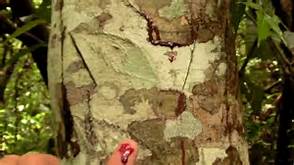 I cant say enough about this wonderful botanical. Training an Australian cattle dogs from a puppy left me with scratches and stinging bite marks that were sore and inflamed and slow to heal. Time after time an application of Dragons Blood sap reduced the burning and inflammation quickly. It’s so effective when applied correctly. Several patents have been taken out on this botanical in Japan and the west. We often hear from surfers or hikers with scrapes, and studies have been done with exterminators who regularly deal with insect bites.
I cant say enough about this wonderful botanical. Training an Australian cattle dogs from a puppy left me with scratches and stinging bite marks that were sore and inflamed and slow to heal. Time after time an application of Dragons Blood sap reduced the burning and inflammation quickly. It’s so effective when applied correctly. Several patents have been taken out on this botanical in Japan and the west. We often hear from surfers or hikers with scrapes, and studies have been done with exterminators who regularly deal with insect bites.
Sangre de grado, or “dragon’s blood,” can be found high in the upper Amazon regions of Peru, Ecuador, and Columbia. Full of imagery, this name was given to the plant because when its trunk is breached a dark red, sappy resin resembling blood oozes from it.
While its name evokes a plant of immense strength, this botanical is not overpowering in size. At maturity, it reaches 10-20 meters high with a modest trunk boasting a diameter of only 30 centimeters or less. The trunk is covered with smooth, mottled bark and its stalks hold large, heart-shaped, green leaves and greenish-white flowers.1 The earliest written reference to Croton lechleri dates to the 17th century, when Spanish Jesuit missionary, naturalist, and explorer, Bernabé Cobo encountered the use of the plant’s resin by indigenous tribes throughout Mexico, Peru and Ecuador.[11] This discovery was greatly overshadowed in Europe by his description of cinchona bark, or Jesuit’s bark, which was instrumental in the discovery and isolation of quinine.
How is it used?
Dragon’s Blood is different from many other botanicals because it is the sap that is harvested and used as a health supplement. The sap is often applied topically to the skin, but is also used orally even though the taste is quite tannic. While the sap can be tapped and harvested from wild trees, fortunately, trees grown on small jungle plots near villages grow very quickly, and local farmers are able to harvest and rotate crops in a 2-3 year cycle.2 Dragons Blood has a long history of use by indigenous peoples and is widely used today in both urban and rural regions areas especially in Peru, Brazil and Ecuador, and to a lesser extent in other Amazonian countries. For centuries, the sap has been used to cover abrasions, cuts, scratches, blisters, bites and stings to seal wounds and injuries to protect from infection. The sap dries quickly, forming a barrier similar in thickness to the top layer of skin and is considered by some as a “second skin.”
Why does it help the body?
 The blood-red color of the sap of Dragon’s Blood may unlock some of the mysteries behind the traditional use of this botanical. A group of scientists studying the effects of Sangre de grado determined one of the major chemical constituents in the botanical is proanthocyandins—a common component in many plants and one that creates the rich, red color in red wine. One conclusion of their experiments is that the specific arrangements of the complex proanthocyandin oligomers in Sangre de grado provide this botanical with analgesic and attenuated capsaicin responses that other plants with proanthocyandins do not have.3 As a note, that rich, red color will only temporarily stain your skin but may permanently stain clothes.
The blood-red color of the sap of Dragon’s Blood may unlock some of the mysteries behind the traditional use of this botanical. A group of scientists studying the effects of Sangre de grado determined one of the major chemical constituents in the botanical is proanthocyandins—a common component in many plants and one that creates the rich, red color in red wine. One conclusion of their experiments is that the specific arrangements of the complex proanthocyandin oligomers in Sangre de grado provide this botanical with analgesic and attenuated capsaicin responses that other plants with proanthocyandins do not have.3 As a note, that rich, red color will only temporarily stain your skin but may permanently stain clothes.
What conditions does Sangre de grado alleviate?
Adding Sangre de grado to your daily regimen is easy!
It’s easy to shop at Herbs America with our online store. Click here to purchase Dragon’s Blood extract. Adding 1-2 drops in water daily is frequently used to help with digestion, liver function, and skin support. We also offer a blend of Cat’s Claw, Chu Chu Huasi, Clavo Huasca, Sangre de Grado, and Iporuru together as Codizone to help alleviate minor pain.
Learn more and save more!
Stay up-to-date on the latest specials, news, and information from Herbs America. Sign up to receive our newsletter and receive 15% off your first order! CLICK HERE to get started!
Taylor, Leslie. The Healing Power of the Rainforest Herbs, 2005, Text reprinted at: https://rain-tree.com/sangre.htm. ↩
Miller, Mark J.S. et. al., “Inhibition of Neurogenic Inflammation by the Amazonian Herbal Sangre de Grado,” Journal of Investigative Dermatology, Volume 117, Issue 3, September 2001, pages 725-730, published online at: https://www.jidonline.org/article/S0022-202X(15)41372-7/fulltext. ↩
Miller, Mark J.S. et. al., “Inhibition of Neurogenic Inflammation by the Amazonian Herbal Sangre de Grado,” Journal of Investigative Dermatology, Volume 117, Issue 3, September 2001, pages 725-730, published online at: https://www.jidonline.org/article/S0022-202X(15)41372-7/fulltext. ↩

Reader Interactions